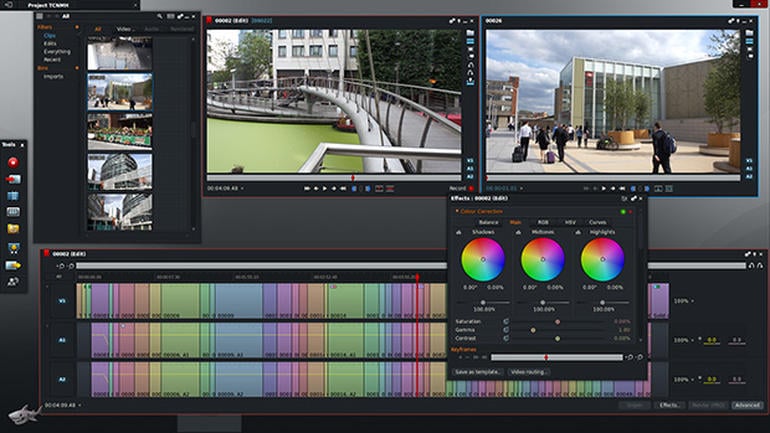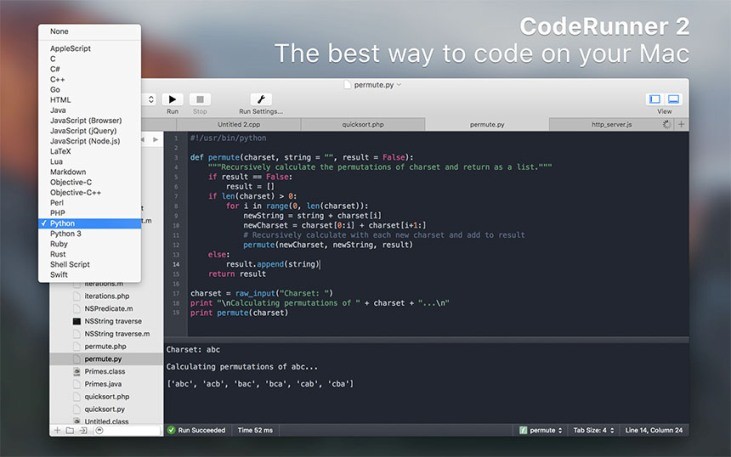
Top 10 Best Free Video Editing Software in 2018 for Mac Users. Many people are looking of free Mac video editing software since they have tons of videos and are eager to edit the videos either for better presentation or preservation. Are there any free video editing software for Mac users that are really good? Many people ask this in forums. Here's a guide to the best photo editing software and apps available for amateur photographers, enthusiasts and professionals. Best Photo Editing Software (PC and Mac). Best for Sharing.
It’s no longer enough for a photo editing application to be great at what it does in isolation. Modern computing is defined by connected workflows. The ability to pass tasks seamlessly between devices, between contexts, and between coworkers is increasingly important. That’s why, despite some potent new competitors, remains our pick for the best photo editing and management application for mainstream users. Lightroom provides a strong editing and photo library management environment, but it also builds a powerful ecosystem of apps, learning resources, and community around those tools. It’s a joint pick, in fact, because Lightroom now exists as two distinct versions: the cloud-first Lightroom CC, and the familiar, more powerful Lightroom Classic CC. Both have their merits, and we’ll discuss what kind of user each is best suited for.
Get Our Best Photography Tips & Workflows Transform your photos and edits from average to awesome with our in-depth, mobile photography course. It’s jam-packed with training, ideas, and lessons that can literally transform your photography overnight. How We Chose It’s important to note that this comparison is specific to photo editors that also provide Digital Asset Management (DAM) features. This all-in-one approach is appealing not only because it provides an integrated workflow, but because it allows you to manage your photo files with more organizational control than a simple file structure would. We’re interested in tools that are designed to take you from initial import and culling all the way to final polish and export. As a result, while standalone editors like, etc. Are fantastic at what they do, they are beyond the scope of this piece.
Main Criteria That first restriction narrowed our field of contenders significantly, and from there we considered the remaining apps according to the following characteristics:. Features and processing quality: It’s all too common to see photo editors judged based on their initial rendering of a file rather than the potential results after processing.
While initial rendering can be a useful data point, it doesn’t say enough about the quality of the processing engine. We took the time to comparatively edit a variety of photos across all the apps in an effort to see which provided the best results up front, which provided the most editing leeway, and which got us from raw file to edited output most efficiently. Design and ease of use: Though much of the core functionality is shared between apps in this category, the way tools are presented, how granular the controls are, and how customizable the interface is can all influence how you work. We looked for something that’s relatively easy to start with, but has room for growth as your needs and skills develop. Ecosystem: A crucial aspect of an app’s appeal is the ecosystem of supporting resources that build up around it, both from the manufacturer and from third parties.
The availability of communities, tutorials, classes, presets, etc. Can not only help with the initial learning process, but also speed up workflows for more confident users. Price and cost structure: Cost is a tricky subject, but in general we’re looking for products that have a clear, understandable cost structure and that feel like good value for money.
Best Photo Editing For Mac 2017

This is very subjective territory and we recognize that there are differing schools of thought on price ranges, single-payment vs. Subscription, and so on that are beyond the scope of this comparison. Is the Best Mainstream Photo Management and Editing App for macOS Adobe has been firing on all cylinders with development this year, introducing an entirely new cloud-first version of the app, establishing a strong cross-platform presence, and improving core processing tools like color profiles. Today’s Lightroom is a refined, ubiquitous environment for managing your photo library, whether you choose the re-thought cloud-based Lightroom CC, or the more familiar, professional-oriented Lightroom Classic CC. Features in Lightroom Classic CC Lightroom Classic CC is the evolution of the familiar Lightroom we know and love. It borrows a limited version of the cloud syncing capabilities from its younger sibling, Lightroom CC, while retaining the robust feature set it’s always had. This includes a powerful catalog system capable of handling thousands and thousands of photos with ease, plus the tools for triaging and organizing those photos quickly.
Similarly, you have thorough metadata editing controls; a deep, nesting keyword system in place to help categorize photos by content; and a map module dedicated to managing geotagging information. When it’s time to edit your selects, Lightroom Classic CC features very capable core editing tools, from exposure, to color balance, to detail. It’s a well-chosen assortment, and most of the sliders are more intelligent than their name suggests, performing several tasks behind the scenes to achieve their intended effect.
This is particularly true of combo sliders like “Dehaze,” which performs several contrast-related adjustments in a single action. Beyond the basics, Lightroom Classic CC includes merging capabilities for processing HDR photo stacks, as well as stitching together panoramas.
These are unique to Lightroom Classic CC, as most other tools require you to handle this kind of task externally. Once you’ve edited your shot, Lightroom Classic CC offers a dedicated print module for preparing for physical output, and you can set up digital export presets in a variety of formats and fidelity settings. Features in Lightroom CC New to Adobe’s ecosystem is Lightroom CC, a streamlined version of the app built around cloud storage and cross-platform sync. Compared to Lightroom Classic CC, Lightroom CC has no Print module or proofing tools, no Map module or support for geotags, no tethering support, no HDR or panorama merging, limited batch editing, limited keyword support, no smart collections (there are only “albums”), no face recognition, no file renaming, no adjustment history, JPG-only export (and only in the sRGB color space), and support for a single catalog only (you can’t create multiple catalogs like you can in Classic CC). This sounds like a lot of missing stuff, but in exchange you get a number of important benefits:.
A unified interface and tool set across Mac, Windows, iOS, Android, and (to a more limited extent), the web and Apple TV. The ability to sync and edit raw files and presets across those platforms (instead of just Smart Previews like with Lightroom Classic CC) and manage storage use on each device separately. Leaner, faster operation. Access to the Adobe Sensei cloud intelligence for smart search and organization without having to manually keyword everything.
Lightroom CC retains all the core photo editing tools from its older sibling, and Adobe has been updating it at a breakneck pace to fill in the functionality gaps. Case in point, Adobe has introduced synced presets, whereby any of your custom presets within Lightroom CC will be automatically synced to Lightroom CC for iPhone, iPad, and even on the web. For many users, the inclusion of synced presets may be the kick to jump over to Lightroom CC full-time. While there is still a large gap between the capabilities of CC vs Classic CC, this gap has dramatically narrowed over time at a very fast pace. Note: Synced presets are only available on Lightroom CC.
Good Photo Editing For Macbook
Presets will not sync between Lightroom CC on the iPhone or iPad and Lightroom Classic CC on the Mac. In the meantime, being able to access and edit your raw files from any device is a spectacular feature, one that genuinely transforms the way you can think about photo processing in ways that adding a new tool here and there really doesn’t. Unlike iCloud Photo Library, Lightroom CC lets you manage storage very precisely, so you can explicitly choose which albums should be stored locally and which should remain in the cloud until you call them down.
Best Mac For Photo Editing
This is crucial for phones and tablets, where storage space is often at a premium. Of course, the fact that it’s cloud-based means that you’ll need a strong internet connection to take full advantage, but assuming you have that, it’s tremendous. While it can be daunting to trust your photo library to the cloud, in my usage, the system has been flawless—no delays, no strange errors, no missing photos. Adobe clearly spent a lot of time making sure the underlying architecture is solid, and it has paid off.

Get Our Best Photography Tips & Workflows Transform your photos and edits from average to awesome with our in-depth, mobile photography course. It’s jam-packed with training, ideas, and lessons that can literally transform your photography overnight. Conclusion With such a low barrier to entry (thanks to the smartphone revolution), it’s no longer just dedicated hobbyists and professionals looking to manage and edit photographs. Everyone can benefit from a good system for organizing, processing, and sharing their shots.
Adobe’s developing Lightroom ecosystem is the ideal choice for most people because it caters to a broad range of needs, from beginner to professional, and does so with the support of a huge community of users, experts, and developers. While it’s true that other options sometimes exceed Lightroom’s capabilities, they tend to do so in specialized ways that don’t impact a normal workflow.
Beyond the details of functionality, though, the main appeal of Lightroom is its forward-thinking, device-agnostic approach to managing photos. It feels decidedly modern, and while it makes ambitious promises, Adobe is certainly well-positioned to deliver on them. If you’re in the market for an all-in-one approach to organizing and editing your photos, Lightroom should be your first stop.
